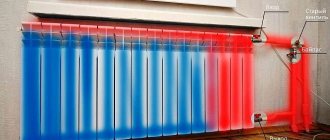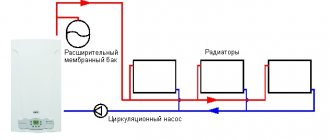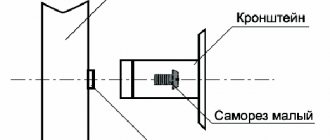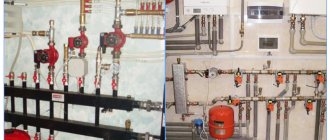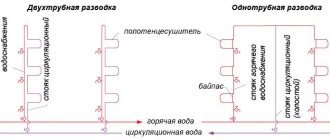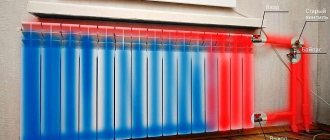Typically, manufacturers provide the ability to bleed air from the heated towel rail through the Mayevsky tap. This manual valve is installed at the top of the ladder posts or at the front end of the shelf heater.
In the absence of an air vent, you can simply loosen the nut securing the PS to the riser. In this case, you should take into account the connection diagram of the device, whether the riser belongs to the hot water supply or heating system, the direction of coolant flow and the floor on which the heated towel rail is installed.
Removing the air lock
The need to bleed air from a heated towel rail arose immediately after the appearance of “ladder” models with several piping schemes. In Soviet times, U-shaped and M-shaped heaters were connected to the heating/DHW system directly, without a bypass; in principle, such problems did not arise.
In the “ladder” modifications, an air lock is formed due to the complex configuration of the tubular structure. Therefore, manufacturers equip their products with one or two manual air vents designed by Mayevsky, hidden inside decorative caps.
With Mayevsky crane
Without the involvement of specialists, a heated towel rail with a Mayevsky tap allows you to ventilate the heating device as needed.
The equipment belongs to the category of air vents, and has a primitive but effective design:
- on one side of the brass body there is a 1/2 or 3/8 inch cylindrical pipe thread;
- Inside there is a through channel for a threaded adjustment screw with a needle-shaped tip;
- the exhaust channel is drilled from the side into the polymer rotary insert.
The screw is unscrewed with a flat screwdriver, air under pressure exits the system into the air channel, the spatial position of which (up/down or sideways) can be adjusted with a rotary insert. As soon as water without air begins to flow into the side channel and the characteristic hissing disappears, the screw is screwed into the working position. The needle closes the hole and the descent stops. More details in the video below:
The main advantage of the needle valve designed by Mayevsky is its small size combined with a cylindrical shape. The device is easily hidden inside decorative glasses screwed onto ladder-shaped heated towel rail racks.
Manufacturers complete the product with a special key or round handle to save the user from even searching for a screwdriver.
In a private cottage with an open heating circuit, there is no need to expel the air; it goes into the expander tank itself. For closed systems, automatic air vents are used.
They are mounted at the top point of the system, and not the heating device, preventing the entire circuit as a whole from being aired.
Typically, float-type diverters are used, as in a flush cistern. Only they work the other way around - in working condition, the float is raised inside the chamber, the hole is blocked, when excess air enters the chamber, the liquid level in it decreases, the float “dives”, opening the drain channel.
Without air vent
If a complex-shaped heated towel rail was initially installed without a Mayevsky tap, removing the air lock from it will be a little more difficult. The general principle of operation is the same - destruction of the tightness of the system to squeeze air into the atmosphere with water pressure. The sequence of actions is as follows:
- the threaded connection is located at the highest point of the system, the riser does not need to be disconnected;
Where to bleed air without a Mayevsky tap. - loosening the coupling, nut, locknut;
- collecting water in a bucket using a rag thrown over the threaded connection, the lower edge of which is lowered into the container;
- tighten the thread after the air hissing stops.
If you remove the plug without a rag, the water-air mixture is sprayed throughout the bathroom uncontrollably, which increases the complexity of subsequent cleaning and can lead to damage to furniture and interior parts.
Attention: When airing a substation with a bottom connection, it is necessary to know the direction of flow in the riser and the insertion height of each pipe. You should unscrew the thread of the pipe coming out of the heated towel rail so that the pressure can push the plug out.
Modern method
This method involves installing a Mayevsky tap on a heated towel rail. Modern models are sold complete with it. Please note that the tap is not responsible for shutting off the water, but serves only as an air vent.
The Mayevsky tap includes a needle valve and an adjusting screw. In order to bleed off the accumulated air, use a flat screwdriver or a special key to turn the screw to open the valve.
The air must be released until hot water flows out of the small hole in a thin stream.
After this, the screw is tightened to the initial position and literally after a few minutes the heated towel rail begins to warm up and then become hot. What to do without a Mayevsky tap if you need to remove air? In this case, you will need the following tools:
- pliers;
- key;
- capacity (at least 10 liters);
- flat screwdriver.
Even without plumbing skills, you can loosen the retaining nut a little and bleed the air. If a gurgling noise appears, do not be alarmed ; this is how the system in which air has previously accumulated is filled with water. If you plan to carry out this operation in an old house, it is better to call an experienced plumber, since the nut may break.
This procedure will have to be carried out several times a year in order for the heated towel rail to function correctly.
Which heated towel rails don't have traffic jams?
According to the current SP and SNiP standards, the heated towel rail must crash into the riser in parallel. In this case, its part between the lower and upper insertion automatically becomes a bypass.
In complex structures with long pipe lengths or their complex geometry (for example, a ladder with shelves), the hydraulic resistance increases sharply. Water does not enter them, preferring the path of least resistance - bypass.
Therefore, this element is narrowed - a piece of the riser is cut out, the PS is connected to it with bends, and the bypass is made from a piece of pipe, the diameter of which is one size smaller than that of the riser.
During Soviet times, a U-shaped heated towel rail in the bathroom was installed directly, without a bypass. It is this option that guarantees the absence of air jams in any direction of flow in the riser.
The problem of airing the PS of the upper floor in houses without hot water supply with hot water pumps during the autumn heat switching on was solved by installing a valve in the attic with a brush under the hose, allowing air to be released along with cold water to start the circulation of the system.
Traditional method
If you follow the traditional method, you will need to expel the water from the heated towel rail . Since it is connected to the water supply system, you just need to drain the water through the riser. The situation becomes more complicated if there are many residential floors above you, since the descent is carried out on the top one.
If this does not help, slowly begin to unscrew the nut that secures the dryer to the pipe. Let us repeat that you need to unscrew it very slowly and as soon as you hear air escaping, you should not unscrew it further. It would be a good idea to place an empty container under the mounting location to prevent water from dripping from the pipe.
Read also: How I searched and found Ikigai
Reasons for airing the system
A plug of air can accumulate at the top point of the ladder heated towel rail in the following cases:
- release of air from the coolant;
- change in temperature;
- oxygen diffusion through polymer pipes;
- chemical reactions that release oxygen.
In areas with low flow rates, air begins to release and accumulate from the hot water. In the absence of grounding of the riser, the materials used for its manufacture and production of PS can form weak galvanic couples that release gases during the decomposition of water molecules. Finally, large quantities of air enter the piping circuits during installation of the device.
In general, when installing or repairing a heated towel rail, there are three possible scenarios. In the first case, there is a bypass and two taps after it; the remaining air in the device can be discharged through the Mayevsky tap.
In the second option, there is no bypass on the riser connected to the central heating; no one is going to do it. Cranes on risers of any type are strictly prohibited by SNiP standards; they can be installed on horizontal lines.
Here, first, water is drained from the riser in the basement of the house; after installing the device, the system is filled under pressure. Therefore, the valve is needed only at the top point of the entrance - either on the heated towel rail in the upper apartment, or on the riser pipes in the attic.
The main problem of the drying device
After a certain period of using the heated towel rail, you will find that it has stopped heating and at that moment is completely cold.
This problem is often faced by residents of multi-storey buildings when the centralized heating system is turned on in the autumn. At this time (when the pipes are filled with water), air may appear in the pipes. Such plugs usually occur in the final parts of the heating system, which is the heated towel rail.
As soon as air appears in the pipes, the high-quality circulation of hot water is disrupted, and accordingly the drying device stops heating.
Leaving your heated towel rail unused for a long time can significantly affect your habits and quality ventilation of the bathroom, because a high level of humidity even in a week can affect the finish of the walls of the room.
If you are planning to install a towel dryer or have already installed it, you must be aware of all its possible problems and how to solve them.
Installing a jumper to allow operation without shutting off the hot water supply
During operation of the heated towel rail, it may be necessary to replace the seals connecting the device to the water supply system. The service life of even the highest quality seals usually does not exceed 3 years. So that when replacing seals or the heated towel rail itself there is no need to shut off the water in the riser, thereby depriving neighbors of the opportunity to use hot water, care should be taken to install a jumper.
This work should be entrusted to a specialist who knows the necessary techniques for connecting pipes. To do this, in the places where the heated towel rail is connected to the riser, you should install ball valves and install a jumper, which also has a valve. With the taps at the inlet and outlet of the device closed and the tap at the jumper open, you can safely work without disturbing the water supply of your neighbors.
The best posts
- Gorodets painting for beginners on wood: templates with photos
- Ladder on bowstrings: features of installation of the structure (fastening and installation of the bowstring)
- Small yellow ants in the apartment: how to get rid of them
- How to functionally use a window sill in a small kitchen?
- Features of use and technical characteristics of hardboard
- DIY origami paper box with lid and surprise
- [Savings] Drywall fireplace: luxury accessible to everyone
- Marble tiles for the bathroom - tips for choosing
Application of the Mayevsky crane
Unscrewing the nuts and lowering the riser should be used only in certain cases, if there are no other options. The method is not the most practical and safe. Models of modern coils have a special air vent, which is called a Mayevsky tap. This is a standard needle valve.
This valve is opened by turning a screw. The small diameter of the holes will not allow you to flood the room with hot water, but only drain the required volume until all the air escapes. There is nothing stopping you from using the most standard water taps to bleed air. But because of them, the residents of the house abused the drainage of water for their own needs. Therefore, in the 30s of the last century, Mayevsky invented such a crane.
Using the Mayevsky crane
The use of Mayevsky’s air vent cannot cause any difficulties for anyone:
- First you need to prepare a container for draining up to 15 liters; you need to place it under the tap itself. It is worth noting that the white plastic area can be rotated in different directions. This allows you to direct a small hole to the desired location.
- After loosening the fixing screw using a screwdriver or the desired nut. As a rule, half a turn is enough to open the valve, and then begin to bleed air. You cannot unscrew the screw too much - then the water pressure will not allow you to screw it into place.
- It is important to wait for the hissing to complete. Clean, air-free water should begin to flow.
- After this, the screw should be put in place.
This completes the process of releasing air. It is much simpler and at the same time extremely safer than unscrewing the nuts or the process of restarting the riser.
How to bleed the air yourself?
As soon as the air is released, the heated towel rail will work again. There are several ways to get rid of excess air in the system.
In old houses, in apartments on the upper floors or even in the attic, there is a special valve for bleeding air from the heating or hot water supply system .
In the first case, you will have to contact directly the residents of the upper apartments, and in the second - to the responsible person who has access to the attic. Most often, he is a mechanic of the management company or a senior housekeeper.
Having reached the tap, you should open it and wait until water flows out of it. To avoid flooding the lower floors, you should prepare in advance by placing any large container under the tap.
After this, the heated towel rail should work. If this does not happen, then the previously performed manipulations should be repeated until a positive result is achieved.
Sometimes access to the tap is difficult for one reason or another, so you can resort to the second, more risky method of bleeding air - loosening the nut with which the heated towel rail is attached to the pipes.
When using it, you will need not only accuracy, but also some tools, namely:
- pliers;
- adjustable wrench;
- large basin (volume from 20 l).
Using pliers, you need to pull out a piece of metal wire, which usually fixes the position of the nut, and gradually loosen it with an adjustable wrench until the hissing of the air being released is heard. To avoid flooding, place a basin under the heated towel rail. Once again, it should be noted that this method is highly not recommended for use in old houses, since there is a high risk of breaking the thread on the nut and flooding everything around. You can resort to it only in the most extreme cases.
The third and easiest way to bleed air is to use special air vents, which are installed during the installation of a heating system in a private house or when replacing a heated towel rail in a city apartment.
Automatic air vent
The design of the auto air vent is as simple as a manual device.
The float, which is connected to the spring-loaded valve, is not able to allow the valve to open if there is no air. If there is air in the device, then the float goes down. This opens the valve and allows air to escape. The valve closes automatically under the influence of water. In this case, the device must be installed at the peak point - otherwise there will be no reliability in good operation.
The article presents all the reasons for the formation and method of eliminating air plugs in the coil. It is important to use the Mayevsky tap and there will be no problems in the heated towel rail.
Automatic air vent design
If problems occur frequently, you need to check whether the heated towel rail is connected correctly. There is often a situation in which bad plumbers interfere with the operation of common house systems. Because of this, even calling a technician will not guarantee correct installation. At the same time, certain types of devices, due to their shape, can inhibit the flow of water, as a result of which they do not warm up well. In situations like these, it is important to consider changing your device. A correctly selected and installed coil will require virtually no manipulation of the air bleed.
Installing the Mayevsky crane
The design of the crane is very simple. The process of installing a Mayevsky tap on your heated towel rail will be just as simple. This should only be done in the summer, when the heating system is turned off . Its main purpose is to bleed air and start the normal operation of the device.
The main task is to choose the right diameter of the faucet so that it matches the diameter of the pipe in the bathroom. There are several design solutions - a tap that can be opened and closed by hand or a screwdriver.
When installing the Mayevsky tap, the outlet hole should be located downward so that the air drains faster.
You can deflate the heated towel rail with your own hands in a matter of minutes. To do this, it is enough to have the means at hand and the necessary tools, as well as follow simple tips.
How to deflate yourself
The procedure for bleeding a bathroom dryer depends on the water supply. If you live in a private house with your own water supply system, you should be aware of its circuit and where you can open the tap to get rid of the air lock.
It is important! In apartment buildings, everything is more complicated. You may have to bleed the entire riser if this is the problem. But first, try starting with a heated towel rail in your apartment. What is described below applies only to old heated towel rails without an air vent (Maevsky tap).
Using an adjustable wrench, unscrew the nut that connects the dryer to the hot water pipe.
The nut should be unscrewed very slowly and carefully, because there is a risk of stripping the thread, especially on old Soviet-era heated towel rails
Also prepare a container in advance and place it under the heated towel rail. Having loosened the nut a little, you should wait until the hissing stops and water flows out without air. Then the nut can be screwed back on.
If this method does not help, then you need to bleed the air from the entire riser. And here it all depends on the building where you live, because the riser designs in all houses are different:
- Old five-story Soviet-built buildings: here the hot water riser reaches the 5th floor and makes a loop down to recirculate hot water. Since air accumulates at the highest point of the system, you will have to go to your neighbor from the top floor and bleed the air from the pipes there. Often a hose is already prepared there, which needs to be put on a special tap at the top of the riser, lowered into the sewer and, opening the tap, drain the water until the air disappears.
- Nine-story panel buildings: here you can only bleed air from the attic, since all communications end there. Check if you have access to the attic space. Usually only plumbers from DEZ can go there, then you need to call them. If the attic is open, you can drain the water yourself; the technique is similar: find the hot water pipe and the outlet from it, open the tap and drain the water into the sewer.
- Other houses: in this case, your only option is to call the maintenance service, since the technical floors are usually closed. The procedure is called “restarting the riser”, during which the entire hot water riser is drained in the basement and then filled with water again.
